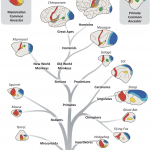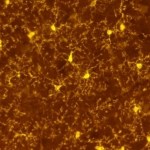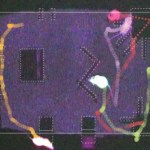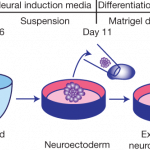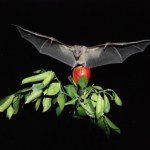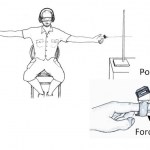neurobiology
The ever-charming Sam Harris has smarmily connected me to Deepak Chopra, so now I'm getting a flood of both smug, superior cluelessness from the Vulcans of Planet Sam, and the spacey vacuous nonsense of the Chopralites. Thanks, Sam! Although, I must say, so far Chopra freaks are doing a better job of actually saying something. Which isn't saying much.
They seem to be impressed with this fatuous defense of dualism from Chopra. I'm going to skip virtually all of the noise to focus on one point that I found particularly annoying.
In the case of brain science, there will be much better knowledge…
The EU is sinking €1.2bn (and the US is proposing to spend more, $3 billion) into a colossal project to build a supercomputer simulation of the human brain. To which I say, "What the hell? We aren't even close to building such a thing for a fruit fly brain, and you want to do that for an even more massive and poorly mapped structure? Madness!" It turns out that I'm not the only one thinking this way: European scientists are exasperated with the project.
"The main apparent goal of building the capacity to construct a larger-scale simulation of the human brain is radically premature," Peter…
Since mental health problems are estimated to affect some 10% of the world’s population, it stands to reason that if you don’t suffer from depression, anxiety or bipolar disorder yourself, you are probably close to someone who does. So you might be pleased to read about a new finding that could eventually lead to a whole new approach to treating this group of common mood disorders.
The finding is that a tiny scrap of RNA – a microRNA that works in the brain – acts as a sort of mood regulator. It works something like the needle in a steam valve. Mice that had high levels of this particular…
Virginia Hughes tells us about techniques to look inside the zebrafish brain. The gang at HHMI are using two photon imaging and clever image analysis to get very clear, sharp images of fluorescent neurons.
Oy, that's pretty. This old codger did some of that stuff, many years ago, but you know what we had to do? Point injections of tracer dyes, followed by serial sectioning and reconstruction. Early on we use injections of horseradish peroxidase into, for instance, the muscle, so that neurons in transit through the lesion site would pick up the enzyme…and then we'd have to fix and process…
What does it take to get Carl Zimmer to review your research in the New York Times?
I suppose it helps to be at Harvard. It also helps to have a combination of subjects — evolution and the human brain — that Zimmer has written about in the past. It helps to have a paper with lots of very pretty diagrams — the authors' hypothesis is professionally illustrated. It's also a good idea to have a vast sweeping explanation for the exceptionalism of the human brain. In this case, they call it the Tethering Hypothesis, and it's supposed to explain how humans evolved all these remarkable cognitive…
I've been distracted lately — it's end of the world semester time — and so I didn't have time to comment on this recent PNAS paper that reports on dramatic sex differences in the brains of men and women. Fortunately, I can just tell you to go read Christian Jarrett, who explains most of the flaws in the study, or you can look at these graphical illustrations of the magnitude of the differences. I just want to add two lesser points.
First, let's all be really careful about the overselling of fMRI, 'k? It's a powerful tool, but it's got serious spatial and temporal resolution limitations, and…
More science-themed haikus. I seem to keep writing them because we tend to put out three “mini press releases” at a time (a relic of the days when they were printed on two sides of a fold-up page and mailed). So I could pick just one to blog about, or I could try to fit all three into one post (which tends to get muddled when it is on subjects as varied as physics, neurobiology and genetics). Or else I can leave these little breadcrumbs inviting you to follow them back to our website, where the fuller explanation awaits (or, from there, you can follow the links in the releases to get to the…
What effect does a constant stream of engaging stimuli have on our relationships? On our social structure as a whole? What percentage of our actions is influenced by others, and how does this translate, at some point, into group behavior?
Neurobiologists Prof. Alon Chen and Dr. Elad Schneidman of the Weizmann Institute and their team members have been using mice to investigate these questions. Chen and Schneidman approach the group as a network composed of the joint behavior patterns of mice that had had their fur dyed in bright, glow-in-the-dark colors. Among other things, this enables the…
While we've been waiting and waiting for the physicists to get their act together and deliver on Mr Fusion home energy sources and flying cars, the biologists have been making great progress on the kinds of things that turn biologists on. The latest development: growing tiny little human brains in a bucket. Only let's not call them brains…they are cerebral organoids. Hugo Gernsback would be so proud.
Here's the latest development. Start with embryonic human stem cells, or induced pluripotent stem cells (cells which you've reset to a kind of embryonic state by using a virus to transfect them…
Take a bunch of peculiar individuals, put them all together in one setting; film their every move, every second of the day. Sound familiar? Dr. Tali Kimchi is explicit about the resemblance of her experiments to a well-known reality TV show. The difference, of course, is that Kimchi’s subjects are mice. She places large groups of animals in a common pen in her lab, which is fitted out with video cameras, infrared lighting for nighttime filming and electronics to continuously record information from the ID chips implanted in each mouse. And while no one can deny that our enjoyment at seeing…
To attain knowledge, add things every day. To attain wisdom, remove things every day.
Lao Tsu
Apparently our nervous systems develop according to the Chinese philosopher’s principle of being and not being. As our nerve cells grow, they send out long extensions – axons – throughout the developing tissues. And as they reach out, some are also pruned back. The configuration of nerve endings we finally possess depends on both what was added and what was removed.
Which axons will complete their developmental journeys and which will be pruned back? For some, it is simply a matter of fate.
But in…
When we navigate through our environment, do we track mostly in two dimensions or in three? Clearly, we can move in all three dimensions, but does our internal map relate to the vertical direction in the same way as it does to the horizontal axes on the ground?
That question has not yet been definitively answered, but recent research on flying bats shows us what three-dimensional navigation looks like in the brain.
It turns out that fruit bats also mostly navigate in two dimensions, since quite a bit of their flying time involves getting from their caves straight to their favorite fruit…
Wow. Talk about major failure. A new study out correlates levels of Foxp2 with levels of vocalization in rats: basically, male rats squeak more than female pups when they're stressed by separation from their mothers, and mothers tend to rescue the rat who squeaks the loudest. They then found higher levels of Foxp2 in males, and also found that reducing male Foxp2 levels in male pups with siRNA also reduced vocalizations. So far, so good; looks like a reasonable and interesting experiment. Then they extended it to humans half-assedly, finding that 4 year old boys have lower levels of Foxp2 in…
Weizmann Institute scientists have created a “white smell.” Think about white light or white noise: Each mixes a bunch of different waves together from various parts of the visual or audible spectrum. Those wavelengths combine such that we perceive that unobtrusive light or sound we call “white.”
How do smells fit into this scenario? Prof. Noam Sobel and his group have already shown that smells have their own spectrum – ranging from pleasant to unpleasant – and that this relates to the chemical structure of the odor molecules. Is this spectrum truly analogous to that of light or sound? That…
We have been told what it’s like to be a bat or a bird; now Prof. Ehud Ahissar and Dr. Avi Saig are getting people to experience what it’s like to be a rat. Specifically, they want the participants in their studies to learn what it’s like to locate things in the dark by twitching their whiskers.
The point, of course, is not to get humans to pretend they are actually rats, but to see how they learn to sense the world with a new sense. Whisking is a fairly complex sense, involving spatial coordinates – horizontal, vertical and distance from the base of the whisker – and timing. It only works…
I've got to wonder who is responsible for this nonsense, and how it gets past the staff at Newsweek. Every once in a while, they've just got to put up a garish cover story touting the reality of Christian doctrine, and invariably, the whole story is garbage. This time around, the claim is proof of life after death, in Heaven Is Real: A Doctor’s Experience With the Afterlife. This time, we have a real-live doctor who has worked at many prestigious institutions, as we are reminded several times in the story, whose brain was shut down and who then recites an elaborate fantasy of visiting heaven…
“Imagine that you wake up in the morning feeling nothing special, yet you find yourself inexplicably behaving just a bit differently during the day. For example, you take a sniff every time you hear a tone,” says Prof. Noam Sobel. Of course, the people this actually happened to knew they had volunteered for a sleep experiment in Sobel’s lab. They knew that their sleep patterns had been closely monitored. But they had no recall, whatsoever, of the “lesson” they had learned while snoring peacefully. It was the sniffing that gave it away: While asleep, they had undergone conditioning to…
The mirror test is a well known indicator for some degree of self-awareness: surreptitiously mark an animal's face, show it a mirror, and see if it recognizes that the reflected image is of itself by whether it reaches up to touch or remove the mark. We see that behavior and infer that the animal has some knowledge of itself and can recognize that the mirror image is not another animal.
But now robots are being specifically programmed to pass the mirror test.
Ow. It makes my brain hurt.
So this is a computer that has no other indicators of consciousness or awareness or autonomous "thought" (…
A recent meeting of neuroscientists tried to define a set of criteria for that murky phenomenon called "consciousness". I don't know how successful they were; they've come out with a declaration on consciousness that isn't exactly crystal clear. It seems to involve the existence of neural circuitry that exhibits specific states that modulate behavior.
The neural substrates of emotions do not appear to be confined to cortical structures. In fact, subcortical neural networks aroused during affective states in humans are also critically important for generating emotional behaviors in animals.…
There is an extremely common sort of experiment to understand plasticity of the developing brain. These are important experiments to understand an important phenomenon: the brain does not simply unfold ineluctably to produce a fully functional organ, but actually interacts constantly with its environment to build a functioning organ that is matched to the world it must model and work with. This was one of the very first things I learned as a budding neuroscientist; my first undergraduate research experience was in the lab of Jenny Lund at the University of Washington, where we were given…
